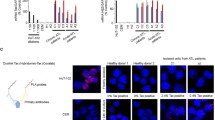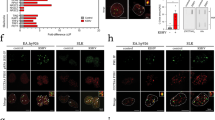Abstract
Telomerase is a complex ribonucleoprotein enzyme that exhibits elevated activity in the majority of cases of human leukemia. We have previously shown that retroviral expression of the catalytic subunit of telomerase, human telomerase reverse transcriptase (hTERT), in human cord blood CD34+ cells leads to an enhanced survival of mature hematopoietic cells. The mechanism for this pro-survival effect is not known. Here, we show that telomerase may play a role in leukemogenesis as a survival factor, independent of its role in maintaining telomere length. Retroviral expression of hTERT in the cytokine-dependent, human hematopoietic progenitor cell line, TF-1, resulted in the survival of cells following the withdrawal of cytokine, with protection from apoptosis, but did not promote unlimited replicative potential. This hTERT-mediated effect on cell survival does not involve Bcl-2 family members, results in accumulation of cells in G1 and appears to operate via autocrine expression of IL-3 and activation of the p53/p21 pathway. Survival in the absence of cytokine stimulation was also observed following retroviral expression of hTERT in normal cord blood CD34+ cells. This study demonstrates a novel pro-survival role for hTERT and may have important implications for the role of hTERT in the pathogenesis of leukemia and drug resistance.
This is a preview of subscription content, access via your institution
Access options
Subscribe to this journal
Receive 12 print issues and online access
$259.00 per year
only $21.58 per issue
Buy this article
- Purchase on Springer Link
- Instant access to full article PDF
Prices may be subject to local taxes which are calculated during checkout







Similar content being viewed by others
References
Elwood N . Telomere biology of human hematopoietic stem cells. Cancer Control 2004; 11: 77–85.
Yamada O, Oshimi K, Motoji T, Mizoguchi H . Telomeric DNA in normal and leukemic blood cells. J Clin Invest 1995; 95: 1117–1123.
Ohyashiki JH, Ohyashiki K, Iwama H, Hayashi S, Toyama K, Shay JW . Clinical implications of telomerase activity levels in acute leukemia. Clin Cancer Res 1997; 3: 619–625.
Engelhardt M, Mackenzie K, Drullinsky P, Silver RT, Moore MA . Telomerase activity and telomere length in acute and chronic leukemia, pre- and post-ex vivo culture. Cancer Res 2000; 60: 610–617.
Ohyashiki JH, Sashida G, Tauchi T, Ohyashiki K . Telomeres and telomerase in hematologic neoplasia. Oncogene 2002; 21: 680–687.
Holt SE, Shay JW . Role of telomerase in cellular proliferation and cancer. J Cell Physiol 1999; 180: 10–18.
Blasco MA . Telomerase beyond telomeres. Nat Rev Cancer 2002; 2: 627–633.
Bodnar AG, Ouellette M, Frolkis M, Holt SE, Chiu CP, Morin GB et al. Extension of life-span by introduction of telomerase into normal human cells. Science 1998; 279: 349–352.
Vaziri H, Benchimol S . Reconstitution of telomerase activity in normal human cells leads to elongation of telomeres and extended replicative life span. Current Biology 1998; 8: 279–282.
Elwood NJ, Jiang XR, Chiu CP, Lebkowski JS, Smith CA . Enhanced long-term survival, but no increase in replicative capacity, following retroviral transduction of human cord blood CD34+ cells with human telomerase reverse transcriptase. Haematologica 2004; 89: 377–378.
Kitamura T, Tange T, Terasawa T, Chiba S, Kuwaki T, Miyagawa K et al. Establishment and characterization of a unique human cell line that proliferates dependently on GM-CSF, IL-3, or erythropoietin. J Cell Physiol 1989; 140: 323–334.
Re MC, Monari P, Gibellini D, Ciancianaini P, Dall'Aglio PP, Vignoli M et al. Human T cell leukemia virus type II increases telomerase activity in uninfected CD34+ hematopoietic progenitor cells. J Hematother Stem Cell Res 2000; 9: 481–487.
Weinrich SL, Pruzan R, Ma L, Ouellette M, Tesmer VM, Holt SE et al. Reconstitution of human telomerase with the template RNA component hTR and the catalytic protein subunit hTRT. Nat Genet 1997; 17: 498–502.
Howrey RP, El-Alfondi M, Phillips KL, Wilson L, Rooney B, Lan N et al. An in vitro system for efficiently evaluating gene therapy approaches to hemoglobinopathies. Gene Therapy 2000; 7: 215–223.
McCowage GB, Phillips KL, Gentry TL, Hull S, Kurtzberg J, Gilboa E et al. Multiparameter-fluorescence activated cell sorting analysis of retroviral vector gene transfer into primitive umbilical cord blood cells. Exp Hematol 1998; 26: 288–298.
Rudoll T, Phillips K, Lee SW, Hull S, Gaspar O, Sucgang N et al. High-efficiency retroviral vector mediated gene transfer into human peripheral blood CD4+ T lymphocytes. Gene Therapy 1996; 3: 695–705.
Hoang T, Paradis E, Brady G, Billia F, Nakahara K, Iscove NN et al. Opposing effects of the basic helix-loop-helix transcription factor SCL on erythroid and monocytic differentiation. Blood 1996; 87: 102–111.
Knight MJ, Riffkin CD, Muscat AM, Ashley DM, Hawkins CJ . Analysis of FasL and TRAIL induced apoptosis pathways in glioma cells. Oncogene 2001; 20: 5789–5798.
Stier S, Cheng T, Forkert R, Lutz C, Dombkowski DM, Zhang JL et al. Ex vivo targeting of p21Cip1/Waf1 permits relative expansion of human hematopoietic stem cells. Blood 2003; 102: 1260–1266.
Holyoake TL, Jiang X, Jorgensen HG, Graham S, Alcorn MJ, Laird C et al. Primitive quiescent leukemic cells from patients with chronic myeloid leukemia spontaneously initiate factor-independent growth in vitro in association with up-regulation of expression of interleukin-3. Blood 2001; 97: 720–728.
Hanauer A, Mandel JL . The glyceraldehyde 3 phosphate dehydrogenase gene family: structure of a human cDNA and of an X chromosome linked pseudogene; amazing complexity of the gene family in mouse. EMBO J 1984; 3: 2627–2633.
Nicoletti I, Migliorati G, Pagliacci MC, Grignani F, Riccardi C . A rapid and simple method for measuring thymocyte apoptosis by propidium iodide staining and flow cytometry. J Immunol Methods 1991; 139: 271–279.
Jordan CT, Yamasaki G, Minamoto D . High-resolution cell cycle analysis of defined phenotypic subsets within primitive human hematopoietic cell populations. Exp Hematol 1996; 24: 1347–1355.
Colgin LM, Wilkinson C, Englezou A, Kilian A, Robinson MO, Reddel RR . The hTERTalpha splice variant is a dominant negative inhibitor of telomerase activity. Neoplasia 2000; 2: 426–432.
Antonchuk J, Sauvageau G, Humphries RK . HOXB4 overexpression mediates very rapid stem cell regeneration and competitive hematopoietic repopulation. Exp Hematol 2001; 29: 1125–1134.
Gentry T, Smith C . Retroviral vector-mediated gene transfer into umbilical cord blood CD34brCD38-CD33- cells. Exp Hematol 1999; 27: 1244–1254.
Vaux DL, Cory S, Adams JM . Bcl-2 gene promotes haemopoietic cell survival and cooperates with c-myc to immortalize pre-B cells. Nature 1988; 335: 440–442.
Mandal M, Kumar R . Bcl-2 modulates telomerase activity. J Biol Chem 1997; 272: 14183–14187.
Cory S, Huang DC, Adams JM . The Bcl-2 family: roles in cell survival and oncogenesis. Oncogene 2003; 22: 8590–8607.
Kang SS, Kwon T, Kwon DY, Do SI . Akt protein kinase enhances human telomerase activity through phosphorylation of telomerase reverse transcriptase subunit. J Biol Chem 1999; 274: 13085–13090.
Ezoe S, Matsumura I, Satoh Y, Tanaka H, Kanakura Y . Cell cycle regulation in hematopoietic stem/progenitor cells. Cell Cycle 2004; 3: 314–318.
Comalada M, Xaus J, Sanchez E, Valledor AF, Celada A . Macrophage colony-stimulating factor-, granulocyte-macrophage colony-stimulating factor-, or IL-3-dependent survival of macrophages, but not proliferation, requires the expression of p21(Waf1) through the phosphatidylinositol 3-kinase/Akt pathway. Eur J Immunol 2004; 34: 2257–2267.
Gartel AL, Serfas MS, Tyner AL . p21 – negative regulator of the cell cycle. Proc Soc Exp Biol Med 1996; 213: 138–149.
Bartek J, Lukas J . Pathways governing G1/S transition and their response to DNA damage. FEBS Lett 2001; 490: 117–122.
Weiss RH . p21Waf1/Cip1 as a therapeutic target in breast and other cancers. Cancer Cell 2003; 4: 425–429.
Cao Y, Li H, Deb S, Liu JP . TERT regulates cell survival independent of telomerase enzymatic activity. Oncogene 2002; 21: 3130–3138.
Dudognon C, Pendino F, Hillion J, Saumet A, Lanotte M, Segal-Bendirdjian E . Death receptor signaling regulatory function for telomerase: hTERT abolishes TRAIL-induced apoptosis, independently of telomere maintenance. Oncogene 2004; 23: 7469–7474.
Stewart SA, Hahn WC, O'Connor BF, Banner EN, Lundberg AS, Modha P et al. Telomerase contributes to tumorigenesis by a telomere length-independent mechanism. Proc Natl Acad Sci USA 2002; 99: 12606–12611.
Acknowledgements
We thank the BMDI Cord Blood Bank for supply of human cord blood for research purposes. This work was supported by the Leukemia Research Fund of the Royal Children's Hospital, the Leukaemia Auxiliary of the Royal Children's Hospital, the Murdoch Children's Research Institute and a University of Melbourne Early Career Grant.
Author information
Authors and Affiliations
Corresponding author
Additional information
Supplementary Information accompanies the paper on the Leukemia website (http://www.nature.com/leu)
Supplementary information
Rights and permissions
About this article
Cite this article
Li, S., Ferguson, M., Hawkins, C. et al. Human telomerase reverse transcriptase protects hematopoietic progenitor TF-1 cells from death and quiescence induced by cytokine withdrawal. Leukemia 20, 1270–1278 (2006). https://doi.org/10.1038/sj.leu.2404251
Received:
Revised:
Accepted:
Published:
Issue Date:
DOI: https://doi.org/10.1038/sj.leu.2404251
Keywords
This article is cited by
-
MYC-dependent downregulation of telomerase by FLT3 inhibitors is required for their therapeutic efficacy on acute myeloid leukemia
Annals of Hematology (2018)
-
New prospects for targeting telomerase beyond the telomere
Nature Reviews Cancer (2016)
-
Correction of copper metabolism is not sustained long term in Wilson’s disease mice post bone marrow transplantation
Hepatology International (2008)
-
Telomeres, senescence, and hematopoietic stem cells
Cell and Tissue Research (2008)



